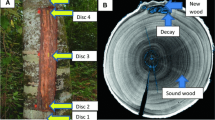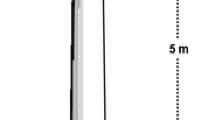Abstract
Though Cinnamomum zeylanicum is a very important commercial aromatic bark yielding and oldest known tree spice of India, there are hardly any studies to understand the nature of wound healing and bark recovery. Further, optimal number of sprouts to be retained under coppice system to maximize the bark yield per tree in C. zeylanicum is not yet standardized. The present investigation was carried out to understand the influence of patch geometry and application of post-bark-extraction-protection treatments on bark regeneration in mature trees as well as to standardize an optimal number of sprouts to be retained under coppice system to maximize the bark yield per tree. In general, wound healing in C. zeylanicum occurred from the edge of the blaze and was quicker in the narrower patch than the broader patch; application of Bordeaux paste or neem seed kernel extract on the blazed area immediately after the bark extraction, resulted in significantly higher mean percent bark recovery and higher bark oil content than control. Allowing seven coppice sprouts per stem resulted in higher dry mass of bark per plant and higher bark oil than other treatments under coppice system. The results of the study would enable formulation of management strategies specifically for sustainable bark harvesting in Cinnamomum species.

Similar content being viewed by others
Data availability
Data relating to this manuscript will be made available from the corresponding author on reasonable request.
References
Abeysinghe, P. D., Wijesinghe, K. G. G., Tachida, H., Yoshda, T., & Thihagoda, M. (2009). Molecular characterization of Cinnamon (Cinnamomum verum Presl) accessions and evaluation of genetic relatedness of Cinnamon species in Sri Lanka based on trnL intron region, intergenic spacers between trnT-trnL, trnL-trnF trnH-psbA and nuclear ITS. Research Journal of Agriculture and Biological Sciences, 5(6), 1079–1088.
Baldauf, C., & Dos Santos, F. A. M. (2014). The effect of management systems and ecosystem types on bark regeneration in Himatantus drasticus (Apocynaceae): Recommendations for sustainable harvesting. Environmental Monitoring and Assessment, 186, 349–359.
Delvaux, C., Sinsin, B., Darchambeau, F., & Damme, P. V. (2009). Recovery of bark harvesting of 12 medicinal tree species in Benin, West Africa. Journal of Applied Ecology, 46, 703–712.
Delvaux, C., Sinsin, B., & Van Damme, P. (2010). Impact of season, stem diameter and intensity of debarking on survival and bark re-growth pattern of medicinal tree species, Benin. West Africa. Biological Conservation, 143(11), 2664–2671.
Delvaux, C., Sinsin, B., Van Damme, P., & Beeckman, H. (2013). Size of conducting phloem: The “key” factor for bark recovery of 12 tropical medicinal tree species. Flora, 208, 111–117.
Guedje, N. M. (2002). La gestion des populations of d’arbes comme outil pour une exploitation durable des produits forestiers non-ligneux: l exemple de Garcinia lucida (sud: Cameroun). The Trophenbas-Cameroon Programme, Kribi, and Universite Libre de Bruxelles, Brussels, 2002. Trpenbos-Cameroon Series 5, XVIII.
Gursale, A., Dighe, V., & Prakash, G. (2010). Simultaneous quantitative determination of cinnamaldehyde and methyl eugenol from stem bark of Cinnamomum zeylanicum Blume using RP-HPLC. Journal of Chromatographic Science, 48, 59–62.
Hall, P., & Bawa, K. (1993). Methods to assess the impact of extraction of non-timber tropical forest products on plant-populations. Economic Botany, 47, 234–247.
Juan, D., Xie, H. L., Zhang, D. Q., He, X. O., Wang, M. J., Li, Y. Z., Cui, K. M. & Lu, M. J. (2006). Regeneration of the secondary vascular system in poplar as a novel system to investigate gene expression by a proteomic approach. Proteomics, 6, 881–895.
Khandekar, R. G., Pethe, U. B., Nawale, R. N., Haldankar, P. M., Jadhav, B. B., & Anandaraj, M. (2012). Standardization of stem thickness and length for harvesting Cinnamon (Cinnamomum verum J. Pres.) bark. Journal of Spices and Aromatic Crops, 21(2), 164–168.
Khandekar, R. G., Sawant, V. S., Haldankar, P. M., & Malshe, K. V. (2016). Effect of retention of sprouts on bark leaf yield in Cinnamon (Cinnamomum verum J. Pres). Green Farming,7(4), 966–969.
Kumar, N., Abdul Khader, J. B., Rangaswami, P., & Irulappan, I. (2006). Introduction to spices, plantation crops, medicinal and aromatic plants, Oxford & IBH Publishing Co. Pvt. Ltd., New Delhi.
Nene, Y. L., & Thapliyal, P. N. (1993). Fungicides in plant disease control (3rd ed.). Oxford and IBH Publishing Company Private Limited.
Pandey, A. K. (2015). Sustainable bark harvesting of important medicinal tree species in India. In: Shackleton, C. M., Pandey, A.K., & Ticktin T. (Eds.), Ecological sustainability for non-timber forest products: dynamics and case studies of harvesting. Routledge, New York, NY 10017, USA.
Pandey, A. K., & Mandal, A. K. (2012). Sustainable harvesting of Terminalia arjuna (Roxb.) Wight & Arnot (Arjuna) and Litsea glutinosa (Lour.) Robinson (Maida) bark in Central India. Journal of Sustainable Forestry, 31, 294–309.
Pathiratna, L. S. S., Perera, M. K. P., & Wijesuriya, E. W. (2004). Performance of Cinnamon (Cinnamomum verum J, Pres.) intercropped at different spacings of Rubber (Hevea brasiliensis Muell. Arg.). Natural Rubber Research, 57(2), 150–158.
Priya, J., & Maridass, M. (2008). Inter-species relationship of Cinnamomum species using RAPD marker analysis. Ethnobotany Leaflets, 12, 476–480.
Sawant, V. S., Khandekar, R. G., Gurav, S. G., & Haldankar, P. M. (2015). Effect of retention of branches on bark yield in Cinnamon. Journal of the Indian Society of Coastal Agricultural Research, 33(2), 66–68.
Ticktin, T. (2004). The ecological implications of harvesting non-timber forest products. Journal of Applied Ecology, 41, 11–21.
Acknowledgements
The authors are grateful to the Dean (Forestry), College of Forestry Sirsi, University of Agricultural Sciences, Dharwad, and the members of Advisory Committee for their valuable help during the research work. The authors are also grateful to Shri. Sadananda B. Goudar, Farmer, Edur, Soraba taluk, Shivamogga district and Prasad Hegde, Progressive farmer, Kankodlu, Yellapur district for their valuable cooperation in conducting the research work in their farms. We also thank Dr. Swamy, K.R., Ph. D. Students and M.Sc. Students of 2018-2020 batches and final B.Sc. Forestry 2018-2019 and 2019-2020 batches for their valuable help during collection of data and samples. This is a part of the Ph.D. (Forestry) thesis submitted to the University of Agricultural Sciences, Dharwad, by the first author.
Author information
Authors and Affiliations
Corresponding author
Ethics declarations
Conflict of interest
The authors declare no competing interests.
Additional information
Publisher's Note
Springer Nature remains neutral with regard to jurisdictional claims in published maps and institutional affiliations.
Rights and permissions
About this article
Cite this article
Hanumantha, M., Vasudeva, R. Influence of patch geometry, post-bark-extraction-treatment on bark recovery and standardizing number of sprouts for bark harvest from coppices in Cinnamomum zeylanicum blume: implications for sustainable harvesting. Environ Monit Assess 194, 214 (2022). https://doi.org/10.1007/s10661-022-09882-0
Received:
Accepted:
Published:
DOI: https://doi.org/10.1007/s10661-022-09882-0




